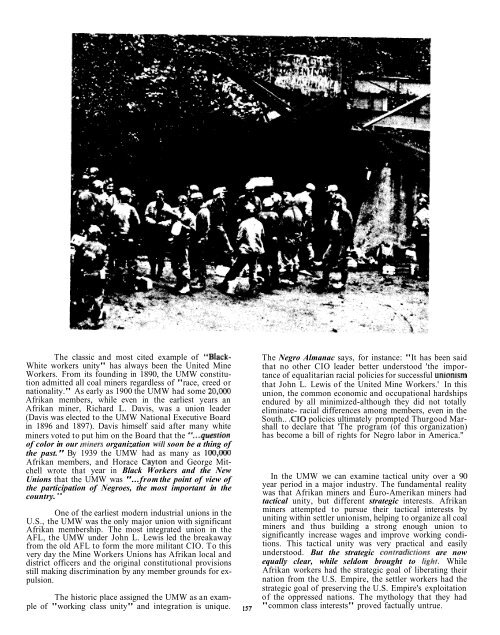Settlers - San Francisco Bay Area Independent Media Center
Settlers - San Francisco Bay Area Independent Media Center
Settlers - San Francisco Bay Area Independent Media Center
You also want an ePaper? Increase the reach of your titles
YUMPU automatically turns print PDFs into web optimized ePapers that Google loves.
The classic and most cited example of "Black-<br />
White workers unity" has always been the United Mine<br />
Workers. From its founding in 1890, the UMW constitution<br />
admitted all coal miners regardless of "race, creed or<br />
nationality." As early as 1900 the UMW had some 20,000<br />
Afrikan members, while even in the earliest years an<br />
Afrikan miner, Richard L. Davis, was a union leader<br />
(Davis was elected to the UMW National Executive Board<br />
in 1896 and 1897). Davis himself said after many white<br />
miners voted to put him on the Board that the "...question<br />
of color in our miners organization will soon be a thing of<br />
the past." By 1939 the UMW had as many as 100,000<br />
Afrikan members, and Horace Cayton and George Mitchell<br />
wrote that year in Black Workers and the New<br />
Unions that the UMW was "...from the point of view of<br />
the participation of Negroes, the most important in the<br />
country. "<br />
One of the earliest modern industrial unions in the<br />
U.S., the UMW was the only major union with significant<br />
Afrikan membership. The most integrated union in the<br />
AFL, the UMW under John L. Lewis led the breakaway<br />
from the old AFL to form the more militant CIO. To this<br />
very day the Mine Workers Unions has Afrikan local and<br />
district officers and the original constitutional provisions<br />
still making discrimination by any member grounds for expulsion.<br />
The historic place assigned the UMW as an example<br />
of "working class unity" and integration is unique.<br />
The Negro Almanac says, for instance: "It has been said<br />
that no other CIO leader better understood 'the importance<br />
of equalitarian racial policies for successful unionlsm<br />
that John L. Lewis of the United Mine Workers.' In this<br />
union, the common economic and occupational hardships<br />
endured by all minimized-although they did not totally<br />
eliminate- racial differences among members, even in the<br />
South.. .CIO policies ultimately prompted Thurgood Marshall<br />
to declare that 'The program (of this organization)<br />
has become a bill of rights for Negro labor in America.''<br />
In the UMW we can examine tactical unity over a 90<br />
year period in a major industry. The fundamental reality<br />
was that Afrikan miners and Euro-Amerikan miners had<br />
tactical unity, but different strategic interests. Afrikan<br />
miners attempted to pursue their tactical interests by<br />
uniting within settler unionism, helping to organize all coal<br />
miners and thus building a strong enough union to<br />
significantly increase wages and improve working conditions.<br />
This tactical unity was very practical and easily<br />
understood. But the strategic contradicfions are now<br />
equally clear, while seldom brought to light. While<br />
Afrikan workers had the strategic goal of liberating their<br />
nation from the U.S. Empire, the settler workers had the<br />
strategic goal of preserving the U.S. Empire's exploitation<br />
of the oppressed nations. The mythology that they had<br />
"common class interests" proved factually untrue.

















